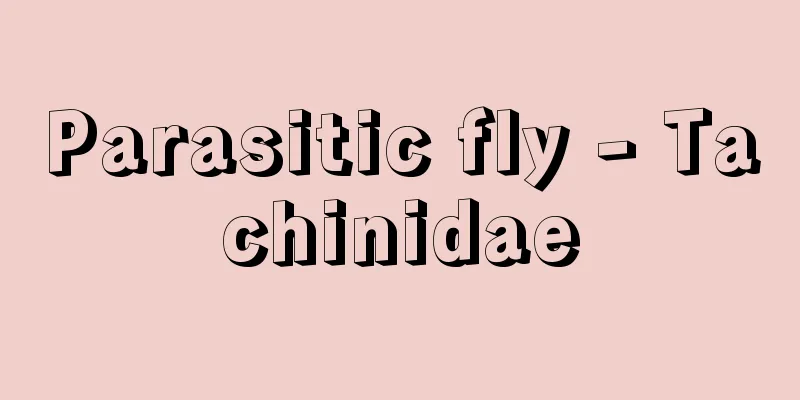Nanso Satomi Hakkenden - Nanso Satomi Hakkenden

|
A reader from the Edo period. Written by Kyokutei Bakin. A total of nine volumes, 106 books, and 180 episodes. It was published by Yamazaki Heihachi, Minoya Jinzaburo, and Chojiya Heibei in Edo between 1814 (Bunka 11) and 1842 (Tenpo 13). Illustrations were provided by Yanagawa Shigenobu, Keisai Eisen, Yanagawa Shigenobu II, and Utagawa Sadahide. [Takeshi Tokuda] SynopsisAfter losing the Battle of Yuki in Shimousa in 1441, Satomi Yoshizane crossed over to Awa to restore the Satomi clan. However, he was attacked by Anzai Kagetsura and suffered hardship. As a reward for his achievement of biting Kagetsura to death, Yoshizane gave his beloved daughter, Fusehime, to his pet dog, Yatsufusa. In a cave in Toyama, Fusehime was touched by Yatsufusa's spirit, and eight jewels, representing the virtues of benevolence, righteousness, courtesy, wisdom, loyalty, faith, filial piety, and brotherly love, and white spirit came out of her womb. Later, the Eight Dog Warriors, Inuzuka Shino, Inukawa Sousuke, Inuyama Dosetsu, Inukai Genpachi, Inuda Kobungo, Inue Shinbei, Inuzaka Keno, and Inumura Daikaku, were born in various places, and after encountering many dramatic events and repeated strange comings and goings, they gathered together as vassals of the Satomi family. Kanrei Ougigaya Sadamasa and Yamauchi Akisada raised a large army to attack the Satomi family, but thanks to the efforts of the Eight Dog Warriors, the Satomi family won, and the two sides eventually made peace. The Dog Warriors married eight princesses of the Satomi family, and when they grew old, they went to Toyama and became hermits. It is one of the longest novels in the world, and the structure of the plot, in which the parts and the whole correspond closely to each other, is highly developed. The writing is a powerful mixture of Japanese and Chinese, and makes extensive use of the vocabulary of Chinese vernacular novels. The ideology is based on Confucian exhortation to discipline, Buddhist karma, and bushido. As a result, the characters are puppets of ideology, and the novel was criticized in the Meiji period by Shoyo Tsubouchi in his novel The Essence of Novels for not depicting real people, but in fact there are many parts in which the characters of the time are depicted realistically. It has also been criticized as a literature defending the system based on feudal morality, but in fact there are quite a few parts that use ingenious techniques to indirectly satirize the decadent social conditions and politics of the Tokugawa Ienari era. Although it contains many surrealistic elements, among early modern novels it is in many ways the closest to a modern novel, and its grand scale is highly praised, rivalling "Water Margin" and "Romance of the Three Kingdoms." [Takeshi Tokuda] "Nansō Satomi Hakkenden" edited by Togoro Koike, complete set of 10 volumes (1984-85, Iwanami Shoten) Volume 1: Written by Kyokutei Bakin, published between 1814 and 1842 (Bunka 11 and Tenpo 13), held at the National Diet Library "Legend of the Eight Dogs of Nanso Satomi" Kyokutei Bakin's handwritten manuscript, volume 1, 1834 (Tenpo 5), owned by the National Diet Library "Nansō Satomi Hakkenden" (manuscript) Source: Shogakukan Encyclopedia Nipponica About Encyclopedia Nipponica Information | Legend |
|
江戸時代の読本(よみほん)。曲亭馬琴(きょくていばきん)作。全九輯(しゅう)106冊180回。1814年(文化11)から1842年(天保13)にかけて、江戸の山崎平八、美濃屋(みのや)甚三郎、丁字屋平兵衛(ちょうじやへいべえ)から刊行された。挿絵は柳川重信(やながわしげのぶ)、渓斎英泉(けいさいえいせん)、柳川重宣、2世柳川重信、歌川貞秀(うたがわさだひで)が分担。 [徳田 武] あらすじ嘉吉(かきつ)元年(1441)の下総(しもうさ)の結城(ゆうき)合戦に敗れた里見義実(よしざね)は、安房(あわ)に渡って里見家を再興した。が、安西景連(かげつら)に攻められて苦しみ、景連をかみ殺した功績に報いて飼犬八房(やつふさ)に愛娘伏姫(ふせひめ)を与えた。伏姫は富山(とやま)の洞窟(どうくつ)において八房の気に感応し、仁義礼智(ち)忠信孝悌(てい)の8個の珠(たま)と白気がその胎内から出た。のち、犬塚信乃(しの)、犬川荘介(そうすけ)、犬山道節(どうせつ)、犬飼現八(いぬかいげんぱち)、犬田小文吾(こぶんご)、犬江親兵衛(しんべえ)、犬坂毛野(けの)、犬村大角(だいかく)の八犬士が各地に出生し、波瀾(はらん)に富む事件に出会いつつ数奇な離合を繰り返し、やがて里見家に集まって家臣となる。管領(かんれい)扇谷定正(おうぎがやつさだまさ)、山内顕定(あきさだ)は里見家を討とうと大軍を催したが、八犬士の活躍によって里見家は勝利を得、やがて双方は和睦(わぼく)する。犬士は里見家の8人の姫と婚姻し、老いてからは富山に入って仙人となった。 世界でも有数の長編で、部分と全体が緊密に照応した筋(すじ)の構成力はたいそう発達している。文章は雄渾(ゆうこん)な和漢混交文で、中国の白話(はくわ)小説の語彙(ごい)を多用する。思想は儒教に基づく勧懲主義と仏教的な因果応報律および武士道が基本をなしている。そのために人物が思想の傀儡(かいらい)となっていて、生きた人間が描かれていないという批判を、明治に入って坪内逍遙(しょうよう)の『小説神髄』から投げかけられたこともあるが、当時の人間像が写実的に描かれているところも多い。また封建道徳にのっとった体制擁護文学だなどと批判されたりするが、実は徳川家斉(いえなり)時代の退廃した世相と政治を、巧妙な技法を用いて婉曲(えんきょく)に風刺する部分が少なからずある。超現実的な趣向が多くみられるが、近世小説のなかではもっとも近代小説に近づいた諸点を備え、『水滸伝(すいこでん)』や『三国志演義』に匹敵する雄大なスケールも高く評価される。 [徳田 武] 『小池藤五郎校訂『南総里見八犬伝』全10冊(1984~85・岩波書店)』 巻1 曲亭馬琴作 1814~1842年(文化11~天保13)刊国立国会図書館所蔵"> 『南総里見八犬伝』 曲亭馬琴自筆稿本 巻1 1834年(天保5)国立国会図書館所蔵"> 『南総里見八犬伝』(稿本) 出典 小学館 日本大百科全書(ニッポニカ)日本大百科全書(ニッポニカ)について 情報 | 凡例 |
<<: Mount Nantai - Mount Nantai
Recommend
rifle
〘 noun 〙 (rifle) = rifle (━ gun) ※ Documents relat...
Husák, G. (English spelling) HusakG
…A Central European republic that existed from 19...
Oonamuchi-no-Mikoto
...In particular, there are many articles about t...
Ushitsu
〘Noun〙 "Ushichinisha (Ushichinisha)" or ...
Madame Butterfly
An opera by Italian composer Puccini. Two acts. I...
Sunrise [town] - Hinode
A town in Nishitama County, bordering Ome City in ...
Miri-no-sho
A manor in Aki County, Aki Province. It is also ca...
Japanese ground beetle
...A species endemic to Japan. Its head and thora...
Trolley bus - toro-ri-bus (English spelling)
A rail vehicle that does not require rails to run...
Federal Trade Commission Act
…The AT Act is made up of three main statutes: th...
Hirotari Nakajima
Year of death: 21st January, 1864 (28th February, ...
Senkere
…A ruined city located about 15 km southeast of U...
A letter of thanks
...Jointing is a method of joining boards togethe...
Standard state - hyojunjoutai (English spelling) normal state
Generally, it refers to the state of a gas at a p...
Fo Guang Shan (English name)
The center of Buddhism in Taiwan Province, China. ...









